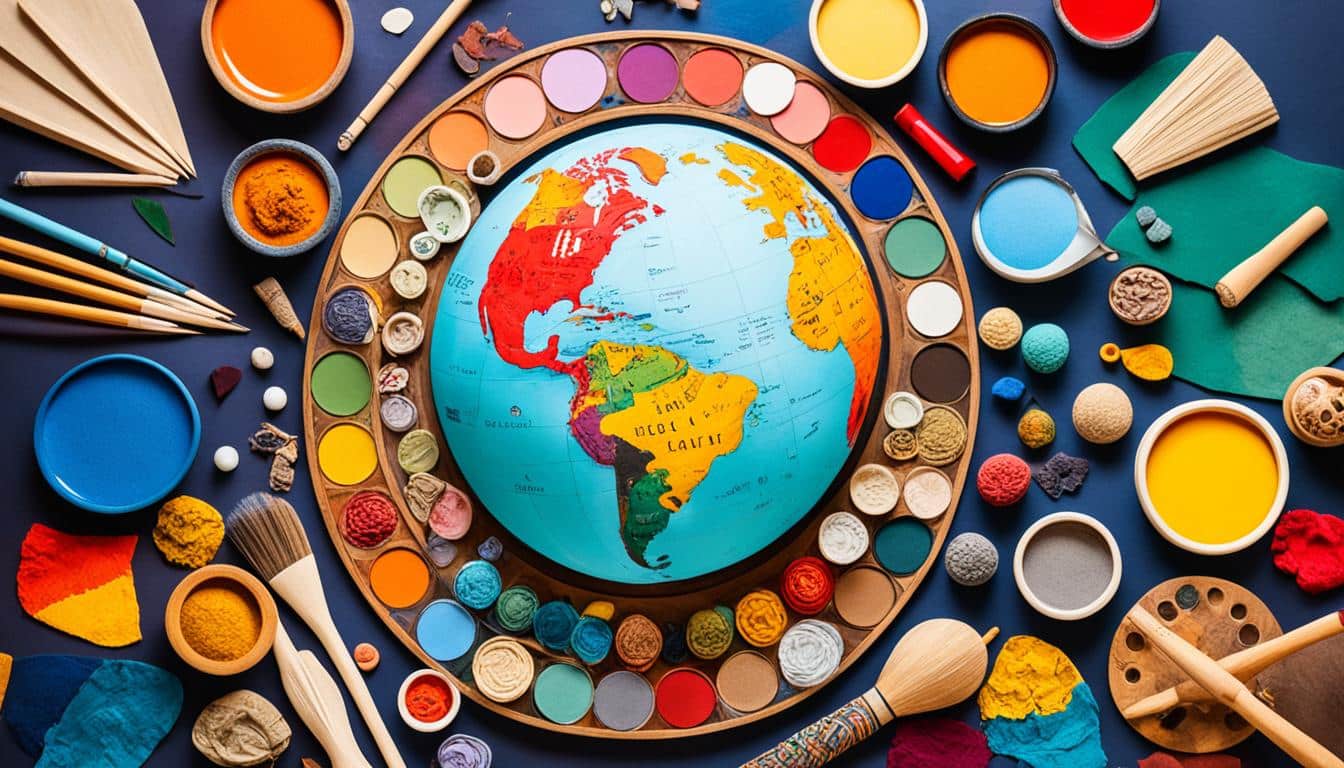Table of Contents
ToggleThe visual arts sector is booming, merging art and tech into global industries. People everywhere want more chances for educational opportunities to launch their careers soon. Teachers and advocates see the immense value of the arts in all areas of life. They know arts education boosts creativity, cultural understanding, and helps students shine in school and beyond.
Key Takeaways
- Arts education fosters creativity and cultural understanding among students.
- Hands-on arts education opportunities can prepare students for diverse career paths.
- Advocates and educators recognize the value of arts in expression, connection, and healing.
- Arts education enhances students’ personal growth and academic success.
- Integrating arts education can help create a well-rounded and engaging learning environment.
The Importance of Arts Education
The importance of arts in early education is huge. It helps students be creative and express themselves. This lets k-12 arts students show who they are. They do this through creating art and experiencing different arts and culture activities. These don’t just teach them how to enjoy art. They also learn skills that help them grow and do well in school.
Fostering Creativity and Self-Expression
The arts education ecosystem is like a safe place for k-12 arts students. Here, they can try new things and find what art means to them. They get to learn about all sorts of art forms, like drawing, music, dance, and acting. This makes them more creative and helps them share who they are.
Developing Critical Thinking and Problem-Solving Skills
But arts education does more than just foster creativity. It also helps students think carefully, solve problems, and be innovative. Arts education research shows these are skills students can use in all parts of their life. That’s because, in art, students learn to see things from different angles. This helps them be ready for the future.
Promoting Cultural Understanding and Appreciation
Arts education is also key for learning about cultures and showing respect. It does this by sharing arts from many different places. Through celebrating the impact of arts and exploring the arts education opportunities, students learn to value the variety of human expression. This makes them more open-minded and respectful of others. Art helps create a more inclusive world.
Also Read : Remote Work Policy: Why Is It Essential For Modern Businesses?
Arts Education and Cultural Enrichment
Arts education is key in showing students the many cultural expressions out there. They get to dive into visual arts, music, dance, and theater. This opens their eyes to different communities and their traditions.
Exploring Diverse Art Forms
Arts education lets students look at the beauty in cultures, both at home and worldwide. This makes them understand and appreciate different traditions. By studying various art forms, students learn to think critically and be creative. They strive to be caring, involved citizens of the world.
Celebrating Cultural Traditions and Heritage
It’s through arts education that cultural traditions and heritage are highlighted and saved. Whether it’s through traditional plays or modern art from new communities, students get to see the world’s richness and diversity. Making sure all students can learn through the arts is crucial. It’s a big part of a complete education that focuses on thinking and creating.
Also Read : What Types Of Job Training Are Most Valuable In Today’s Workforce?
Arts Integration in the Classroom

The arts are integrated into class lessons to mix different studies together. This helps students learn in creative ways, making them think hard, solve puzzles, and be inventive. They do this by linking their art skills with what they learn in other subjects.
Interdisciplinary Learning
Schools combine art classes, music programs, and other creative lessons with regular subjects. This method makes learning richer and more fun. Students see how all fields are related, so they understand the world better.
Project-Based Learning Through the Arts
Through projects like painting or working in theater, students grow more confident in what they know. They don’t just read or listen; they create. This way, they get better at thinking and solving problems by using their hands and minds together.
Also Read : Job Interview Tips: How Can I Prepare Effectively?
Arts Education and Social-Emotional Learning

Arts education is key in helping students learn about social-emotional learning. It lets them grow empathy and understanding. They see the world from different points of view. This is by appreciating diverse arts and experiences. Many art forms involve working together, like making music or acting. This teaches skills like communication and working in a team, too.
Building Empathy and Understanding
The arts give a special place for students to share their feelings. This helps them know themselves and others better. Students get to see life from other shadings. They can connect with different cultures and ideas. This makes a more welcoming and caring community.
Enhancing Communication and Collaboration Skills
Student art projects are all about working together. They need to talk clearly and listen to each other when making music or art. This can be from making a painting together to putting on a play. These projects help in building skills like teamwork and expressing ideas well. When teachers add the arts to lessons, students get chances to grow in important ways. It helps them in school and in their lives later on.
Also Read : How Can Competency Based Education Enhance Student Learning Outcomes?
Arts Education

Arts education includes a variety of fields – like visual arts, music, dance, and more. It lets students be creative and think a lot. They also learn about different cultures. In arts classes, students get to try painting, making music, and acting. This helps them be creative in their own ways. They can show how they feel and think. Plus, the skills they learn can help in other classes too.
Learning about arts shows you different cultures, anywhere from the US to around the world. It helps students understand and respect different ways of life. Arts classes are really important. They help students think in new ways and learn about the world. They prepare young people to be active, caring, and creative members of society.
Also Read : How Do Remote Work Benefits Impact Company Culture?
Benefits of Arts Education for Students
Art education boosts students’ academic performance. Those involved learn more in language, math, and science. The link between arts and better academic results proves the worth of adding creative activities to lessons.
Arts education doesn’t just help with grades. It also makes students more interested and motivated. Creating art allows students to find what they love and show who they are. This excitement and drive make them learn better and achieve more.
The skills they gain in art, like thinking critically and working with others, are very useful elsewhere. Art education helps students get ready for future jobs. It gives them the ability to change and grow in a fast-changing world.
| Benefits of Arts Education | Description |
|---|---|
| Improved Academic Performance | Those in art programs do better in their studies. |
| Increased Engagement and Motivation | Art-based learning gets students more involved and excited. |
| Development of Transferable Skills | Skills from the arts, like thinking and teamwork, help in other areas too. |
Challenges in Implementing Arts Education
Arts education brings many benefits but faces hurdles in schools. A big issue is the lack of money and limited resources. This means schools often can’t buy art supplies, equipment, or train teachers well. Teachers need full training to include the arts in class lessons. But, many don’t get this training. It makes it hard for them to make lessons fun and powerful with the arts.
| Challenge | Impact | Potential Solutions |
|---|---|---|
| Funding and Resources | Not enough materials, teachers, or equipment for quality arts education | Push for more money in arts education, work with art groups, and creative fundraising |
| Teacher Training and Professional Development | Teachers don’t always know how to use the arts well in class | Have good training before and during teaching, work with experts, and keep learning about arts education |
Fixing these problems needs many steps. We need to push for better arts funding. We should join with local art groups. And, teachers must get more support and training. This way, all kids can enjoy the arts benefits, like being more creative, understanding other cultures, and doing well in everything they try.
Arts Education Advocacy and Partnerships

Ensuring all students get quality arts programs requires strong advocacy and partnerships. This means working with many people, like leaders, school heads, parents, and groups in the community. The goal is to get support and find the resources needed.
Engaging Stakeholders and Community Support
To support arts education, we need the local community on our side. Schools join forces with community arts groups and artists. This helps offer students a wider range of creative experiences. It celebrates their community’s culture and art.
Collaborating with Arts Organizations and Teaching Artists
Building relationships with arts groups and using teaching artists’ skills is key. It boosts the quality and variety of what schools can offer. Through these partnerships, schools can bring in fresh talent and ideas. This guarantees top-notch, fun arts lessons for students.
Culturally Responsive Arts Education
Culturally responsive arts education is key to a learning space that values diversity. It makes all students feel they belong. This teaching method highlights many art forms, artists, and cultural practices. It helps students to find themselves in what they learn. By showing the wealth of different cultural backgrounds, arts education teaches us to understand each other better. It also helps fight against wrong ideas and works toward a society where everyone is treated fairly.
Representation and Inclusivity
This kind of arts education introduces students to many different ways of creating art. It covers a wide range of cultural and identity perspectives. By bringing in art from less-heard-of cultures, it breaks the old way of only focusing on the West. Giving all students a chance to see their culture in art makes them more engaged in learning. It helps them feel they are a vital part of the learning journey.
Celebrating Diversity Through the Arts
The arts let students delve into, express, and honor the diversity in the world. They include activities like music, dance, painting, and drama. This lets students learn and take part in each other’s cultural heritage. They not only learn to respect different viewpoints but also get the courage to share their own stories. It makes the learning space open and welcoming to all.
The Role of Arts Education in Society
Arts education is key to shaping our society. It teaches students empathy and cross-cultural understanding. This way, they learn to value different perspectives and experiences. It makes them more compassionate and respectful. Such learning helps create citizens who care about their communities.
Also, arts education teaches creative skills and innovative thinking. These are vital in today’s creative industries, which help our economy grow. Investing in arts education helps the next generation. It makes them imaginative problem-solvers who benefit their communities both culturally and economically.
Promoting Empathy and Understanding
Arts education lets students explore various art forms and cultures. This cultivates their empathy. They learn to understand and appreciate different viewpoints. Such understanding is vital for a society that’s fair and inclusive. It enables people to work together on big issues.
Fostering Creative Industries and Economic Development
Skills from arts education like creativity and innovation are in high demand in the creative industries. The world’s economic value creative products and services more than ever. So, supporting arts education equips students for these growing fields. It helps communities culturally and economically.
Innovative Approaches to Arts Education

Art education is changing along with the world. New tech, like digital art tools and music software, are key. They make learning fun and help students find new ways to use their creativity.
Technology Integration
New technology in arts learning is a game-changer. Students can now try different digital art tools and music software. This makes it easier to turn creative ideas into reality.
Virtual and Augmented Reality Experiences
Virtual and augmented realities are now part of arts education. They let students visit virtual art spaces or mix digital art with the real world. This changes how students experience and make art.
These innovative approaches keep art classes exciting and relevant. They connect the world of art with the modern, digital world.
Also Read : What Are The Key Benefits of Integrating Education Technology?
Conclusion
Arts education is key in forming students in the US. It helps them express themselves and appreciate different cultures. This makes them better citizens. Investing in art programs is crucial for our communities’ growth.
Art classes make students understand different cultures better. They feel connected and active in their communities. Also, skills learned in art, like problem-solving, grooming them for the future.
It’s vital to keep investing in art programs for all students. This ensures future leaders and innovators are ready. Arts are more than just a part of learning. They are essential for students’ growth and understanding of the world.
FAQs
Q: Why is arts education important for K-12 students?
A: Arts education plays a crucial role in providing students with a well-rounded education, fostering creativity, critical thinking, and emotional intelligence essential for their overall development.
Q: How can educators advance arts education in schools?
A: Educators can advocate for the inclusion of comprehensive arts programs in the curriculum, collaborate with arts organizations, and provide professional development opportunities to enhance the quality of arts education.
Q: What is the impact of arts education on student learning?
A: Research has shown that high-quality arts education can improve academic performance, enhance cognitive skills, boost creativity, and contribute to overall student success in various areas of their lives.
Q: How can policymakers support advancing arts education in schools?
A: Policymakers can allocate resources, develop arts education policies, and collaborate with educators and arts organizations to ensure access to high-quality arts education for all students.
Q: How can I contact educators or networks for more information on arts education?
A: You can reach out to organizations like Americans for the Arts, State Arts Agencies, or the Arts Education Partnership for resources, networking opportunities, and support in advancing arts education initiatives.
Q: What is the deadline for submitting applications or proposals related to arts education programs?
A: The deadline for submitting applications or proposals for arts education programs may vary by organization or funding opportunity, so it is essential to check the specific guidelines and timelines provided by the relevant entities.
Source Links
- https://www.forbes.com/sites/rodberger/2022/06/23/the-intersection-of-art-education-and-cultural-awareness/
- https://www.unesco.org/en/articles/what-you-need-know-about-culture-and-arts-education
- https://www.kennedy-center.org/education/resources-for-educators/classroom-resources/articles-and-how-tos/articles/educators/professional-development/fostering-a-culture-of-connection-through-the-arts2/





